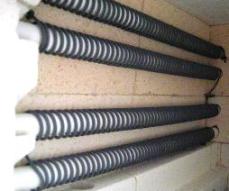DC power supply
Definitions and formulas
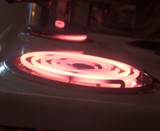 Power Is the work done per unit of time. Electric power is equal to the product of current and voltage: P = U ∙ I. Other power formulas can be derived from here:
Power Is the work done per unit of time. Electric power is equal to the product of current and voltage: P = U ∙ I. Other power formulas can be derived from here:
P = r ∙ I ∙ I = r ∙ I ^ 2;
P = U ∙ U / r = U ^ 2 / r.
We obtain the unit of measurement for power by substituting the units of measurement for voltage and current in the formula:
[P] = 1 B ∙ 1 A = 1 BA.
The unit of measurement for electrical power equal to 1 VA is called watt (W). The name volt-ampere (VA) is used in AC engineering, but only to measure apparent and reactive power.
The units for measuring electrical and mechanical power are connected by the following connections:
1 W = 1 / 9.81 kg • m / s ≈1 / 10 kg • m / s;
1 kg • m / s = 9.81 W ≈10 W;
1 hp = 75 kg • m / s = 736 W;
1 kW = 102 kg • m / sec = 1.36 hp
If you do not take into account the inevitable energy losses, a 1 kW motor can pump 102 liters of water every second to a height of 1 m or 10.2 liters of water to a height of 10 m.
Electrical energy is measured with a wattmeter.
Examples of
1. The heating element of an electric furnace with a power of 500 W and a voltage of 220 V is made of high resistance wire.Calculate the resistance of the element and the current flowing through it (Fig. 1).
We find the current by the formula of electric power P = U ∙ I,
whence I = P / U = (500 Bm) / (220 V) = 2.27 A.
Resistance is calculated by a different power formula: P = U ^ 2 / r,
where r = U ^ 2 / P = (220 ^ 2) / 500 = 48400/500 = 96.8 Ohm.

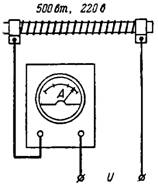
Rice. 1.
2. What resistance should the spiral (Fig. 2) have on the plate at a current of 3 A and a power of 500 W?
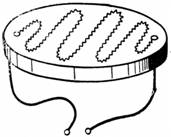
Rice. 2.
For this case, apply another power formula: P = U ∙ I = r ∙ I ∙ I = r ∙ I ^ 2;
therefore r = P/I ^ 2 = 500/3 ^ 2 = 500/9 = 55.5 ohms.
3. What power is converted into heat with a resistance r = 100 Ohm, which is connected to a network with a voltage U = 220 V (Fig. 3)?
P = U ^ 2/r = 220 ^ 2/100 = 48400/100 = 484 W.

Rice. 3.
4. In the diagram in fig. 4 ammeter shows the current I = 2 A. Calculate the resistance of the user and the consumed electric power in the resistance r = 100 Ohm when it is connected to a network with voltage U = 220 V.
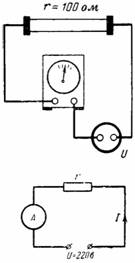
Rice. 4.
r = U / I = 220/2 = 110 Ohm;
P = U ∙ I = 220 ∙ 2 = 440 W, or P = U ^ 2/r = 220 ^ 2/110 = 48400/110 = 440 W.
5. The lamp shows only its nominal voltage of 24 V. To determine the rest of the lamp data, we assemble the circuit shown in fig. 5. Adjust the current with the rheostat so that the voltmeter connected to the lamp terminals shows the voltage Ul = 24 V. The ammeter shows the current I = 1.46 A. What power and resistance does the lamp have and what voltage and power losses occur at the rheostat?
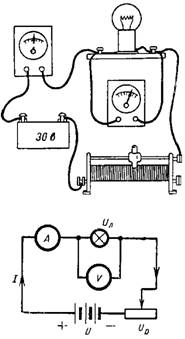
Rice. 5.
Lamp power P = Ul ∙ I = 24 ∙ 1.46 = 35 W.
Its resistance is rl = Ul / I = 24 / 1.46 = 16.4 ohms.
The rheostat voltage drop Uр = U-Ul = 30-24 = 6 V.
Power loss in the rheostat Pр = Uр ∙ I = 6 ∙ 1.46 = 8.76 W.
6. On the plate of the electric furnace, its nominal data are indicated (P = 10 kW; U = 220 V).
Determine what resistance the furnace is and what current passes through it during operation P = U ∙ I = U ^ 2 / r;
r = U ^ 2/P = 220 ^ 2/10000 = 48400/10000 = 4.84 Ohms; I = P / U = 10000/220 = 45.45 A.
7. What is the voltage U at the terminals of the generator, if at a current of 110 A its power is 12 kW (Fig. 7)?
Since P = U ∙ I, then U = P / I = 12000/110 = 109 V.
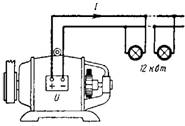
Rice. 7.
8. In the diagram in fig. 8 shows the operation of electromagnetic current protection. At a certain current EM, the electromagnet, held by the spring P, will attract the armature, open the contact K and break the current circuit. In our example, the current protection interrupts the current circuit at a current I≥2 A. How many 25 W lamps can be turned on at the same time at a mains voltage U = 220 V, so that the limiter does not work?

Rice. eight.
The protection is triggered at I = 2 A, i.e. at power P = U ∙ I = 220 ∙ 2 = 440 W.
Dividing the total power of one lamp, we get: 440/25 = 17.6.
17 lamps can be lit at the same time.
9. An electric oven has three heating elements with a power of 500 W and a voltage of 220 V, connected in parallel.
What is the total resistance, current and power when the oven is running (Fig. 91)?
The total power of the furnace is P = 3 ∙ 500 W = 1.5 kW.
The resulting current is I = P / U = 1500/220 = 6.82 A.
Resultant resistance r = U / I = 220 / 6.82 = 32.2 Ohm.
The current of one cell is I1 = 500/220 = 2.27 A.
Resistance of one element: r1 = 220 / 2.27 = 96.9 Ohm.
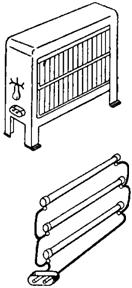
Rice. nine.
10. Calculate the resistance and current of the user if the wattmeter shows a power of 75 W at a mains voltage U = 220 V (Fig. 10).

Rice. ten.
Since P = U ^ 2 / r, then r = U ^ 2 / P = 48400/75 = 645.3 ohms.
Current I = P / U = 75/220 = 0.34 A.
11. A dam has a drop in water level h = 4 m. Every second 51 liters of water enter the turbine through the pipeline. What mechanical power is converted into electrical power in the generator if losses are not taken into account (Fig. 11)?
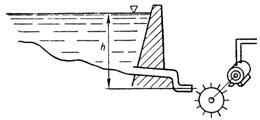
Rice. eleven.
Mechanical power Pm = Q ∙ h = 51 kg / s ∙ 4 m = 204 kg • m / s.
Therefore, the electrical power Pe = Pm: 102 = 204: 102 = 2 kW.
12. What capacity must the pump motor have to pump 25.5 liters of water every second from a depth of 5 m into a tank located at a height of 3 m? Losses are not taken into account (Fig. 12).
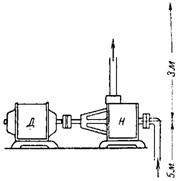
Rice. 12.
The total height of water rise h = 5 + 3 = 8 m.
Mechanical engine power Pm = Q ∙ h = 25.5 ∙ 8 = 204 kg • m / sec.
Electric power Pe = Pm: 102 = 204: 102 = 2 kW.
13. Hydroelectric power station receives from the tank for one turbine every second 4 m3 of water. The difference between the water levels in the reservoir and the turbine is h = 20 m. Determine the capacity of one turbine without considering losses (Fig. 13).
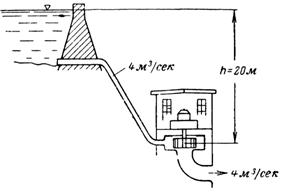
Rice. 13.
Mechanical power of flowing water Pm = Q ∙ h = 4 ∙ 20 = 80 t / s • m; Pm = 80,000 kg • m / s.
Electric power of one turbine Pe = Pm: 102 = 80,000: 102 = 784 kW.
14. In a parallel-excited DC motor, the armature winding and the field winding are connected in parallel. The armature winding has a resistance of r = 0.1 Ohm and the armature current I = 20 A. The field winding has a resistance of rv = 25 Ohm and the field current is Iw = 1.2 A. What power is lost in the two windings of the engine ( Fig. 14)?
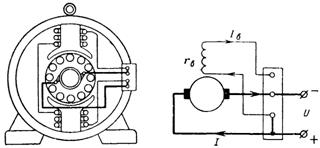
Rice. fourteen.
Power losses in the armature winding P = r ∙ I ^ 2 = 0.1 ∙ 20 ^ 2 = 40 W.
Excitation coil power losses
Pv = rv ∙ Iv ^ 2 = 25 ∙ 1.2 ^ 2 = 36 W.
Total losses in the motor windings P + Pv = 40 + 36 = 76 W.
15. The 220 V hot plate has four switchable heating stages, which is achieved by differentially switching on two heating elements with resistances r1 and r2, as shown in fig. 15.
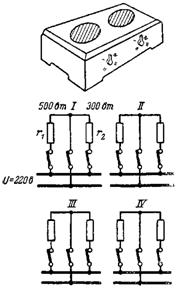
Rice. 15.
Determine the resistances r1 and r2 if the first heating element has a power of 500 W and the second 300 W.
Since the power released in the resistance is expressed by the formula P = U ∙ I = U ^ 2 / r, the resistance of the first heating element
r1 = U ^ 2/P1 = 220 ^ 2/500 = 48400/500 = 96.8 Ohm,
and the second heating element r2 = U ^ 2/P2 = 220 ^ 2/300 = 48400/300 = 161.3 ohms.
In the stage IV position, the resistances are connected in series. The power of the electric stove in this position is equal to:
P3 = U ^ 2 / (r1 + r2) = 220 ^ 2 / (96.8 + 161.3) = 48400 / 258.1 = 187.5 W.
In the stage I position, the heating elements are connected in parallel and the resulting resistance is: r = (r1 ∙ r2) / (r1 + r2) = (96.8 ∙ 161.3) / (96.8 + 161.3) = 60.4 Ohm.
Tile power in step I position: P1 = U ^ 2 / r = 48400 / 60.4 = 800 W.
We get the same power by adding the powers of the individual heating elements.
16. A lamp with a tungsten filament is designed for a power of 40 W and a voltage of 220 V. What resistance and current does the lamp have in the cold state and at an operating temperature of 2500 ° C?
Lamp power P = U ∙ I = U ^ 2 / r.
Therefore, the resistance of the lamp filament in the hot state is rt = U ^ 2 / P = 220 ^ 2/40 = 1210 Ohm.
The resistance of the cold thread (at 20 ° C) is determined by the formula rt = r ∙ (1 + α ∙ ∆t),
whence r = rt / (1 + α ∙ ∆t) = 1210 / (1 + 0.004 ∙ (2500-20)) = 1210 / 10.92 = 118 ohms.
Current I = P / U = 40/220 = 0.18 A passes through the thread of the lamp in a hot state.
The inrush current is: I = U / r = 220/118 = 1.86 A.
When turned on, the current is about 10 times that of a hot lamp.
17. What are the voltage and power losses in the copper overhead conductor of the electrified railway (Fig. 16)?
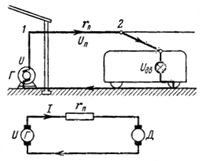
Rice. 16.
The conductor has a cross section of 95 mm2. An electric train engine consumes a current of 300 A at a distance of 1.5 km from the power source.
Loss (drop) of the voltage in the line between points 1 and 2 Up = I ∙ rπ.
Contact wire resistance rp = (ρ ∙ l) / S = 0.0178 ∙ 1500/95 = 0.281 Ohm.
Voltage drop in the contact wire Up = 300 ∙ 0.281 = 84.3 V.
The voltage Ud at the motor terminals D will be 84.3 V less than the voltage U at the source terminals G.
The voltage drop in the contact wire during the movement of the electric train changes. The further the electric train moves away from the source of current, the longer the line, which means the greater its resistance and voltage drop across it. The current on the rails returns to the grounded source G. The resistance of the rails and ground is practically zero.

